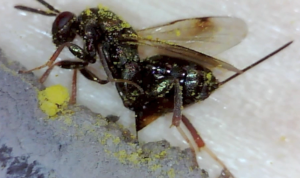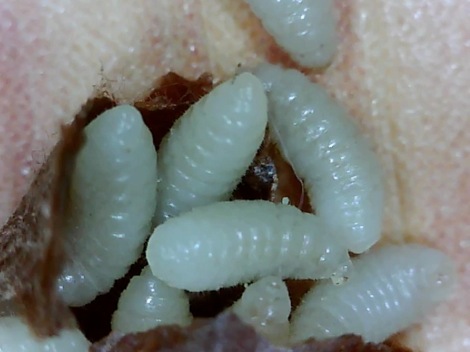Monodontomerus wasp. A silent deadly assassin of Red mason bees
I designed my solitary bee boxes to allow for detailed observations to be carried out without hindering the bees themselves, allowing me to make this video and more! Bees are in decline and need as much help as we can give them. That means research and I am learning more all the time and now have a nest box that allows me and others to do just that!
What do these wasps look like?
They are very small and very agile and determined to achieve their sole mission in life. To lay eggs and pass their genes onto the next generation… see below.
A video of the life cycle of the Monodontomerus wasp, (Monos) a parasitoid of red mason bees, which I made to share, because many people will never have seen this before. If not checked they can devastate your red mason bee cocoons. Full instructions on how best to manage them come with my award winning and successful solitary bee nest boxes.
I was asked to give a presentation to BWARS members at their AGM in the World Museum in Liverpool, 2013. For many years I have learnt how to manage and stop Monos killing my Red mason bees. What if I totally disregarded my own management practices, then made a video by actively allowing them access to the inside of my nest boxes and filmed what happened? So I did and called the presentation, The ‘Design and development of educational wild bee nest boxes allowing for observational studies’. I got the idea to continue with the life cycle video as a result of it. The filming had several positive and negative repercussions, some of which I had not envisaged.
Loosing perhaps 150+ bee larvae in cocoons.
Time and effort spent rectifying the actual loss, damage limitation and potential loss of more bees.
Positives
This experience enabled me to design the nest boxes to give better protection from the wasps.
Rewrite my instructions to give better management control of them for my customers.
I made several informative videos.
I learnt: How devastating they actually are, more about their emergence times, how determined they are to find cocoons, researched how they actually do find them, how successful they can be and much more.
Never to allow Monos into my nest boxes again! Ever!
More knowledge gained about this parasitoid. For example, this wasp is raised and released as a biological control for sawflies that have been accidentally introduced into North America. So if you had an orchard that needed pollinating by Mason bees and it was near a forest. Orchard growers need the Mason bees and foresters need the Monos. A real conflict of industries!
“All my articles and videos, available free, are funded by my teaching and sales of award winning bumblebee nest boxes, solitary bee boxes, and wormeries. Please help by spreading the word and forwarding this link to your friends and colleagues. https://nurturing-nature.co.uk Thank you” George Pilkington
For more information about solitary bees visit BWARS
National Bee Unit (Food & Environment Research Agency) solitary bees info sheet
For info and link to buy an excellent book Field Guide to the Bees of Great Britain and Ireland by Steven Falk
An extremely useful resource supports this book by a special web site feature within Steve Falk’s Flickr web site which furnishes extra photos and other useful resources to assist with identification.
Interested in Citizen Science and Pollinators, visit the Buzz Club
“All my articles and videos, available free, are funded by my teaching and sales of award winning bumblebee nest boxes, solitary bee boxes, and wormeries. Please help by spreading the word and forwarding this link to your friends and colleagues. https://nurturing-nature.co.uk Thank you” George Pilkington



Horrible George!!
What time of the year are these most active and how can this years cocoons be protected ? Do leaf cutters suffer as well??
Marian
Hi Marian, will email you. Cheers, George
I need to know I have a small Larvae just outside the cocoon. It looks different than wasp. Do the leaf cutter larvae come out before becoming a bee?
No, they don’t. Send a decent photo.
I don’t know, George, you keep producing these amazing videos … They deserve wider publicity surely. Such a major contribution to education! More people should see them.
In the meantime, don’t stop!
David
Thanks David. Nice of you to say so!! Hopefully its a drip drip effect re education of these fascinating bees and now people have the knowledge (and nest box!) to do their own observations, studies, research and teaching! Cheers George
Hi George – amazing video. I love my red mason bees too! There is a fly that hangs around the bee houses and nips in to the hole when the bee leaves for pollen or mud. I assume they are laying an egg. Any idea what it might be? Thanks, Jo
Hi Jo, Thanks for comment. Cacoxenus indagator….will be doing an article on it soon! Cheers George
George- brilliant macrovideography…makes anything we might do for an educational video on monos to be superfluous. And as you say, without monitoring and control, they can be devastating for managed solitary bees like the several Osmia species being used (I have 5 species in management and increase here).
yours,
jim
Hi Jim, Thank you for your very kind comments. Its ever so pleasing to receive such comments especially from a solitary bee researcher of 30 years experience such as yourself and working for the United States Dept of Agriculture. Knowing that you have seen my little video taken at home in my garden and felt you had to comment! I really appreciate that. Thanks again, Kind Regards, George
Hi George , great and informative website , I found a mud hive in my shed with large cocoons , and tiny (2mm) what I now no are wasps ovipositing the cocoons , I was just searching for what type of bee / wasp they were , I have learnt a lot today. thanks for the info
My pleasure. Cheers, George
Hello George
Your article is excellent reading and very informative.
This year I made manageable mason bee nest box with 75 chambers 100mm long. These are 5 per row routed 10mm slots,bolted together in a stack.
35 chambers were used fully used and have found 5 chambers that have the wasp larvae in some compartments.
As these are clamped together,is the wasp going in while the bee is making the compartments and laying them?
How do I ensure the Monodontomerus wasp does not invade my chambers?
Regards
Richard
The mono larvae are only inside the cocoon, more likely to be cacoxenus indagator. See if you have any spaghetti type frass in there which will confirm. HTH, Cheers George
Yes you are spot on with your inormation they are cacoxenus indagator larvae.
Thnks for your input George much appreciated.
Richard
Hello George
All my Mason and leaf cutter bee’s are tucked away for the winter. Have tried the candling method that is talked about on some videos,but don’t seem be able to see anything. Do I need to bother about this metod or not?
Richard
Hi Richard, Yes it is worth it. You need a powerful torch and should only keep them on the lens a short time re heating them up. Google it. Cheers, George
Ah thank you!!! I’ve just emptied my bee house (first year of doing this) and discovered a whole load of these larvae! Been researching what they could possibly be then found this so thank you! Luckily saved about 9 cocoons but I think they’d already got to the others. At least now I know and will be ordering your bee house when you get the materials!
Thank you
Fiona
Glad it was helpful Fiona. Best, George
Really enjoy your videos and show them in conservation ecology class. Do you have a US outlet for your nest boxes? Thanks, Ron Carroll
I will email you Ron. Cheers George